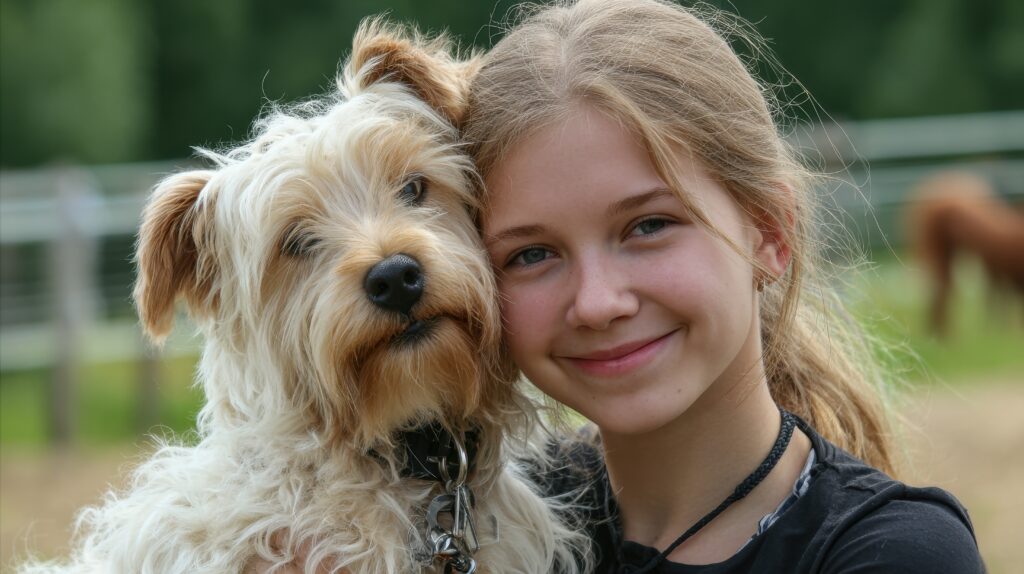How to Socialise Your Dog
Dogs are social animals that thrive when they can properly interact with other dogs, people, and their surroundings. Introducing your dog to new experiences, animals, and humans is essential for their development into a well-adjusted pet. A properly socialised dog is typically happier, more confident, and less likely to develop behavioural problems like aggression or separation anxiety.
Socialising your dog doesn’t just mean letting them run around at the park. True socialisation involves gradually and positively exposing your dog to different environments, people, animals, sounds, and everyday activities. The aim is to help them feel safe and relaxed no matter where they are or who they’re with. reactions.
The ideal time to begin is during puppyhood, but older dogs can benefit from thoughtful, consistent socialisation. With patience and the right techniques, any dog can become more confident and adaptable.
Key Takeaways
- Proper socialisation creates confident dogs who are less likely to develop fear or aggression issues.
- Expose your dog gradually to new experiences, always ensuring interactions remain positive and stress-free.
- Consistency, patience and positive reinforcement are essential tools for successful dog socialisation at any age.
Understanding Canine Socialisation
Socialisation is the process that helps dogs learn to interact appropriately with other animals, people, and their environment. It shapes how your dog will behave throughout their life and creates the foundation for a confident, well-adjusted companion.
Why Socialisation Matters
A well-socialised dog is generally happier, calmer, and easier to live with. They can join you on outings without stress, handle new experiences with confidence, and meet visitors or other pets without overreacting. Dogs who haven’t been properly socialised, on the other hand, may become fearful in unfamiliar situations, leading to behaviours like barking, lunging, or hiding.
The time you invest in socialisation pays off in the long run. Instead of having to manage difficult behaviours later, you’re helping your dog develop healthy responses from the start.
The Crucial Puppy Window
The most important window for socialisation is between three and fourteen weeks of age. Puppies are naturally curious during this period and less likely to react fearfully. It’s the best time to introduce them to people of all ages and appearances, other pets, different environments, and various household sounds and surfaces.
These early interactions don’t need to be long; short, positive exposures are far more effective than lengthy or overwhelming ones. Even after this window closes, it’s important to continue building on those early lessons during your dog’s first year.
Early Experiences Leave a Lasting Impact
Dogs learn through association. A single negative experience, like being startled by a loud noise or chased by another dog, can create a lasting fear. That’s why it’s crucial to control the environment and keep things positive. Pair new experiences with treats, praise, or play so your dog forms a pleasant connection.
Rescue dogs may not have had the benefit of early socialisation, so it’s especially important to go slowly and build trust. Watch their body language and let them set the pace. Forcing interactions can backfire, especially if your dog already feels unsure.
Getting Started Safely
Before you start introducing your dog to the outside world, make sure they’re healthy and protected. Puppies in Australia typically complete their core vaccinations by around 16 weeks. Until then, avoid visiting dog parks. Your vet can guide you on how to balance early socialisation with safety, for example, by carrying your pup in public to expose them to sights and sounds without physical contact.
Once your dog is fully vaccinated, keep up with regular check-ups and parasite prevention, especially if you’ll be visiting shared spaces like beaches or trails.
Vaccinations and Vet Safety
Your dog’s health comes first when planning socialisation activities. Make sure your pup has completed their core vaccinations before exposing them to other dogs or public spaces. In Australia, puppies typically need several rounds of vaccines until they’re about 16 weeks old.
Talk to your vet about local risks like parvovirus or kennel cough. These diseases can be dangerous and even fatal for young dogs.
Your vet can provide a socialisation timeline that balances safety with your dog’s developmental needs. They might suggest carrying your puppy in public places before all their vaccinations are completed, to allow exposure to new sights and sounds without risking infection.
Regular check-ups ensure your dog remains healthy throughout the socialisation process. Keep parasite control up to date as well, since you’ll be visiting various environments.
Choosing the Right Settings
Start your socialisation journey in low-stress places. Familiar environments like your backyard or a quiet street are good starting points. From there, gradually introduce new locations, quiet parks, calm cafés, or pet-friendly stores. Always choose environments that suit your dog’s temperament. Shy or sensitive dogs may need slower introductions, while confident dogs can handle more stimulation.
Aim to provide variety, different surfaces to walk on, new smells, and new people to meet. Perth has many dog-friendly spaces that make great training grounds. Keep sessions short and positive to prevent overwhelm.
Creating Positive Associations
Use high-value treats to reward calm behaviour in new situations. The tastier the treat, the stronger the positive association your dog will form.
Introduce new experiences gradually. If your dog seems uncomfortable with loud noises, start at a distance and move closer as they show comfort. Never force interactions.
Play and praise help your dog connect new experiences with fun. Bring a favourite toy to help them relax in unfamiliar settings.
Watch your dog’s body language carefully. Tail tucking, excessive panting, or avoiding eye contact may signal stress. If you notice these signs, create more distance from the trigger or end the session.
Be patient and consistent. Some dogs need more time to adjust to new experiences. Regular, positive exposure builds confidence over time.
Practical Socialising Techniques
Properly socialising your dog requires consistent practice and the right approach. These techniques will help your dog develop confidence and positive reactions to new situations.
Helping Your Dog Make Positive Associations
When introducing something new, use high-value treats to reinforce calm, curious behaviour. The more enjoyable the experience, the more likely your dog will respond positively next time. If your dog appears uncomfortable—panting excessively, tucking their tail, or avoiding eye contact—give them space or remove them from the situation.
Play can also help your dog relax. Bring a favourite toy and spend time having fun in each new setting. With repetition and encouragement, your dog will start to associate unfamiliar situations with comfort and reward.
Introducing Other Pets and Animals
Meeting other animals should be a positive experience for your dog. Always begin introductions in neutral territory where neither animal feels territorial.
Keep initial meetings brief; about 5-10 minutes is ideal. Watch for signs of stress in both animals and separate them before problems occur.
For dogs meeting cats, maintain control of your dog on a lead while the cat has an escape route. Never force interactions.
Try the parallel walking technique with other dogs: walk alongside each other with space between, gradually decreasing distance as comfort increases.
With livestock or wildlife, use a long lead to maintain control while teaching your dog to remain calm and disinterested.
Be patient and never rush introductions. Some dogs need several meetings before they feel comfortable with certain animals.
Leash Training for Social Situations
A well-trained dog on a lead makes social outings more enjoyable for everyone. Begin by teaching your dog to walk without pulling using a properly fitted collar or harness.
Practice the “heel” command in quiet areas before progressing to more distracting environments. Consistency is crucial; use the same commands and expectations every time.
When approaching other dogs, maintain a relaxed lead. Tension travels down the lead and can make your dog nervous or reactive.
Quick lead techniques to remember:
- Stop walking if your dog pulls, and only continue when there’s no tension
- Change direction frequently to teach your dog to pay attention to you
- Use treats held at your hip to encourage the position beside you
Practice greetings with friends’ dogs who are calm and well-socialised before attempting interactions with unknown dogs.
Rewarding the Right Behaviour
Positive reinforcement is your most powerful training tool. Always reward good behaviour right away, within a second or two—so your dog clearly connects the action to the reward. Use a consistent marker word like “yes” or a clicker to let them know they’ve done well.
Mix up your rewards to keep things interesting. Some dogs are food-motivated, while others prefer praise or toys. Be generous during the early stages, then slowly reduce the frequency once the behaviour becomes a habit.
Remember: socialisation is ongoing. Even well-adjusted adult dogs benefit from continued exposure to new people, places, and experiences.
Expanding Your Dog’s Social Circle
Building a diverse social network for your dog helps them become well-adjusted and confident in various situations. Regular exposure to different environments, animals and people creates a balanced canine companion.
Dog Parks and Public Spaces
Dog parks offer excellent opportunities for your dog to interact with other canines in a safe environment. When visiting, observe your dog’s behaviour and choose times when the park isn’t overcrowded.
Start with short visits of about 15-20 minutes and gradually increase the duration as your dog becomes more comfortable. Always keep a lead handy in case you need to regain control quickly.
Local beaches, walking trails and pet-friendly cafés are also great venues for socialisation. These places expose your dog to various sights, sounds and smells while interacting with others.
Remember to always clean up after your dog and follow local regulations about where and when dogs can be off-lead.
Puppy School and Training Classes
Structured training environments provide controlled socialisation with professional guidance. Puppy school is ideal for dogs between 8-16 weeks old, teaching them valuable social skills during their critical development period.
These classes help your dog learn appropriate play behaviour and communication with other puppies. The trainer can identify potential behavioural issues early and suggest corrections.
For older dogs, obedience classes offer socialisation benefits alongside training. Your dog learns to remain focused despite distractions from other dogs nearby.
Group classes also expose your dog to different handling styles and training methods. This variety helps them adapt to new situations more easily in the future.
Doggy Daycare and Group Outings
Dog daycare provides supervised play in a controlled setting, perfect for dogs who enjoy the company of others. Staff at quality facilities group dogs by size, age and temperament to ensure positive interactions.
Regular attendance helps your dog build lasting friendships with other regular visitors. Many dogs recognise their daycare friends and become excited to see them.
Organised dog meetups or group walks are another excellent option. These gatherings allow your dog to interact with a consistent group of canine friends.
Before enrolling in daycare, visit the facility to assess cleanliness, supervision levels and overall atmosphere. A good centre should require proof of vaccinations and health checks from all attendees.
Interactions with Children and Strangers
Teaching your dog to be comfortable around children is essential. Begin with calm, supervised interactions where the child offers treats and gentle pats.
Never leave dogs and children unsupervised, regardless of how well-behaved either may be. Teach children how to approach and touch dogs properly to prevent misunderstandings.
When meeting strangers, use a loose lead to allow your dog some freedom while maintaining control. Reward calm behaviour with treats and praise.
For nervous dogs, practice “look at that” exercises. Reward your dog for calmly noticing new people from a distance, gradually decreasing the distance over time. This builds positive associations with unfamiliar humans without overwhelming your dog.
Get Your Dog Socialising! Contact Allbreeds For More Information!
Socialising your dog is one of the most rewarding steps you can take to ensure a happy, well-balanced life for your pet. Whether you have a new puppy or an older rescue, it’s never too late to start. At Allbreeds, we understand that every dog is different, and we’re here to guide you with tailored advice, training, and support.
Ready to help your dog build confidence and thrive in new environments? Get in touch with Allbreeds today and give your dog the social start they deserve.



